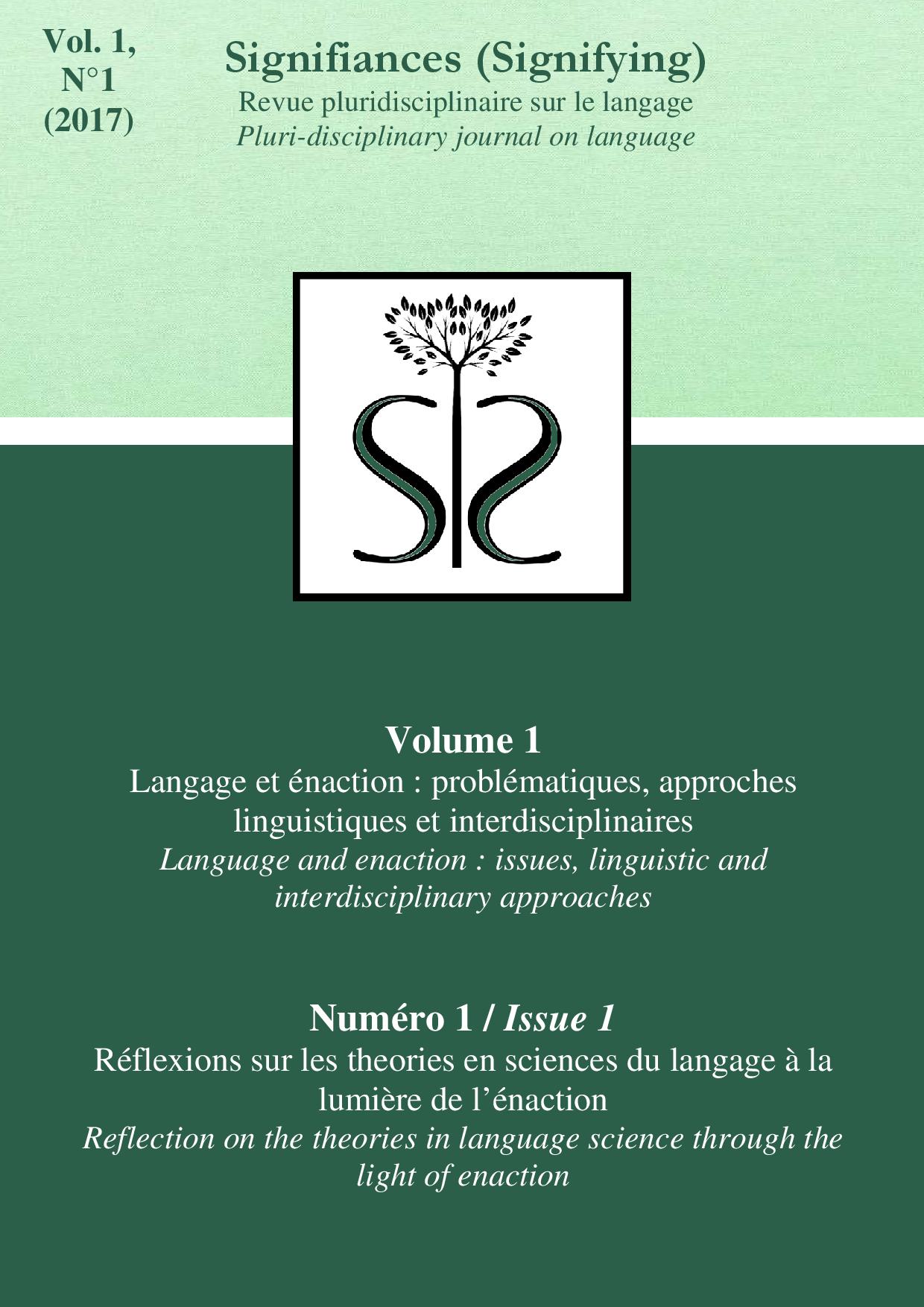La linguistique, un modèle à deux faces
DOI :
https://doi.org/10.52497/signifiances.v1i1.94Mots-clés :
, langage, métalangage, topologie, ensembles ouverts, ensembles fermésRésumé
L’énaction est considérée comme partageant certaines caractéristiques de l’embodiment
(incarnation) et de l’extended mind (esprit étendu) que la linguistique devrait utiliser.
Cependant, leurs orientations respectives sont opposées. La linguistique devrait assurer un
formalisme qui rendrait possible la transition entre ces deux tensions. Or la topologie est
justement une méthode possible en ce qu’elle permet d’opposer le langage, où les unités sont
enchainées au métalangage, où des éléments d’un même paradigme sont choisis.
Références
BOTTINEAU, Didier. (2008). Language and enaction. Dans J. Stewart, O. Gapenne & E. Di Paolo (dir.). Enaction: towards a new paradigm for cognitive science. Cambridge : MIT. 1-67.
GREGOIRE, Michäel (2012). Le lexique par le signifiant. Méthode en application à l’espagnol. Saarebruck : Presses Académiques Francophones.
KUTAS, Marta & VAN PETTEN, Cyma. (1994). Psycholinguistics electrified: Event-related potencial investigations. Dans M. A. Gernsbacher (Dir.), Handbook of Psycholinguistics. New York : Academic Press. 83-143.
KRASHEN, Stephen. (1982). Principles and Practice in Second Language Acquisition. Oxford: Pergamon.
LEWONTIN, Richard. (1983). The Organism as the Subject and Object of Evolution. Scientia, 118. 63-82.
LOPEZ-GARCIA, Ángel. (1980). Para una gramática liminar. Madrid. Cátedra.
LOPEZ-GARCIA, Ángel. (1981). Topological linguistics : liminar grammar. Folia Linguistica, XII-2. 267-289.
LOPEZ-GARCIA, Ángel. (1990). Introduction to topological linguistics. University of Minnesota / University of Valencia : Lynx.
LOPEZ-GARCIA, Á. (2011). Neurolinguistics of the lexicon-syntax interface. Dans A. Pamies & D. Dobrovol’skij (Dir.). Linguo-Cultural Competence and Phraseological Motivation. Duisburg: Schneider Verlag. 41-53.
LOPEZ-GARCIA, Ángel. (2014). Los mecanismos neuronales del lenguaje. Ensayo de fundamentación. Valencia: Tirant lo Blanch.
LOPEZ-GARCIA, Ángel, MORANT, Ricardo, PRUNYONOSA, Manuel & MONTANER, Amparo. (2010). Research on first and second language cognition may benefit from small-world network methodology. Forum, 8-2. 267-277.
LOPEZ-GARCIA, Ángel & MORANT, Ricardo. (2013). An empirical investigation of lexical and cognitive networks in the brain. Revista Española de la Sociedad de Lingüística Aplicada, 26. 493-498.
MARTINET, André. (1968). Élements de linguistique générale. Paris: Colin.
MATURANA, Humberto. (1978). Biology of Language : the Epistemology of Reality. Dans G. A. Miller & E. Lenneberg (Dir.). Psychology and Biology of Language and Thought. New York : Academic Press. 27-63.
MORANT, Ricardo. (2014). Análisis experimental de una asociación controlada de campos cognitivos y campos lingüísticos. Lingüística Española Actual, 36/2. 189-202.
MÜNTE, Thomas & HEINZE, H. J. (1994). Event-related negativities during syntactic processing of written words. Dans H. Heinze et alii (Dir.). Cognitive electrophysiology. Boston : Birkhauser.
OSTERHOUT, Lee & HOLCOMB, Phillip (1992). Event-Related brain potentials elicited by syntactic anomaly. Journal of Memory and Language, 31. 785-806.
PETITMENGIN, Claude. (2015). L’énaction comme expérience vécue. Intellectica, 43-1. 85-92.
PRUÑONOSA, Manuel. (2014). Una asociación de campo cognitivo y campo linguistico en español : análisis de un experimento. Lingüística Española Actual, 36/2. 203-229.
SAUSSURE, Ferdinand de. (1916). Cours de linguistique générale. Publié par Charles Bally et Albert Sechehaye. Génève.
SAUSSURE, Ferdinand de. (2002). Écrits de linguistique générale. Publié par Simon Bouquet et Rudolf Engler. Paris : Gallimard.
TOUSSAINT, Maurice. (1983). Contre l’arbitraire du signe. Paris : Didier.
VARELA Francisco J, THOMPSON, Ewan & ROSCH, Eleanor. (1993). L’inscription corporelle de l’esprit: Sciences cognitives et expérience humaine. Paris: Seuil.


